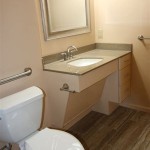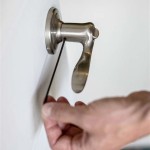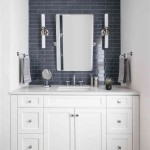Bathroom Sink Pop-Up Stopper Not Working: A Comprehensive Guide to Troubleshooting and Repair
A malfunctioning bathroom sink pop-up stopper is a common plumbing issue that can lead to frustration and inconvenience. When the stopper fails to rise and close the drain properly, water escapes, rendering the sink unusable for filling. Conversely, a stopper that refuses to open can trap water and debris, creating unsanitary conditions. Understanding the mechanics behind the pop-up stopper and identifying the root cause of the problem is crucial for effective troubleshooting and repair. This article explores the various reasons why a bathroom sink pop-up stopper might cease to function correctly, providing a detailed guide to diagnose and resolve the issue.
The pop-up stopper mechanism is a relatively simple yet ingenious design. Typically, it comprises the stopper itself, a lift rod extending from the faucet, a pivot rod connected to the stopper, and a clevis attached to the lift rod. When the lift rod is raised or lowered, it rotates the pivot rod, which in turn raises or lowers the stopper, opening or closing the drain. The system relies on the precise alignment and smooth movement of these components. Any disruption or malfunction within this system can lead to a non-operational stopper.
Identifying Common Culprits: Hair, Debris, and Mineral Buildup
One of the most frequent causes of a malfunctioning pop-up stopper is the accumulation of hair, soap scum, and other debris around the stopper and within the drainpipe. Over time, these materials bind together, creating a sticky mass that impedes the movement of the stopper and the pivot rod. Even a small amount of tangled hair can be sufficient to prevent the stopper from functioning correctly. Mineral buildup, particularly in areas with hard water, can also contribute to the problem. Calcium and magnesium deposits can accumulate on the stopper, pivot rod, and drainpipe, further restricting movement and potentially corroding the components.
To address this issue, a thorough cleaning is often the first and most effective solution. Begin by removing the stopper from the drain. Most stoppers can be removed simply by lifting them straight up. However, some may require a slight twist or rotation to disengage them from the pivot rod. Once the stopper is removed, inspect it carefully for any signs of debris or mineral buildup. Use a stiff brush or an old toothbrush to scrub away any visible residue. A solution of vinegar and water can be particularly effective in dissolving mineral deposits. Allow the stopper to soak in the solution for several hours before scrubbing again.
Next, inspect the drainpipe for any accumulated debris. A small hook or bent wire can be used to retrieve any visible obstructions. Exercise caution when using these tools to avoid damaging the drainpipe. Flushing the drain with hot water can also help to dislodge any remaining debris. In cases of severe blockage, a plumbing snake may be necessary to reach deeper into the drainpipe and remove more stubborn obstructions. Ensure that the area around the pivot rod connection is also cleaned thoroughly, as this is another common area for debris accumulation.
Preventative measures are crucial to minimize the recurrence of this problem. Consider using a drain strainer to catch hair and other debris before they enter the drainpipe. Regularly flushing the drain with hot water can also help to prevent the buildup of soap scum and mineral deposits. Periodically inspecting and cleaning the stopper and drainpipe can help to identify and address potential problems before they escalate.
Addressing Alignment Issues and Mechanical Failures
Beyond simple cleaning, misalignment or mechanical failure within the pop-up stopper mechanism is another common reason for malfunction. The lift rod, pivot rod, and clevis must be properly aligned and securely connected for the system to operate smoothly. Over time, these components can become loose, bent, or broken, leading to improper stopper function. The set screw that secures the pivot rod to the drainpipe can also loosen, causing the pivot rod to slip and preventing the stopper from raising and lowering correctly.
To diagnose alignment issues, begin by inspecting the connection between the lift rod and the clevis. Ensure that the lift rod is securely attached to the clevis and that the clevis is properly positioned on the pivot rod. If the lift rod is bent or damaged, it may need to be replaced. Similarly, if the clevis is cracked or broken, it will need to be replaced. Replacements are readily available at most hardware stores.
Next, check the alignment of the pivot rod. Ensure that the pivot rod is properly inserted into the drainpipe and secured by the set screw. If the set screw is loose, tighten it carefully. Be careful not to overtighten the screw, as this can damage the pivot rod or the drainpipe. If the pivot rod is bent or corroded, it may need to be replaced. Corrosion can particularly affect the movement of the pivot rod, hindering its ability to rotate freely.
In some cases, the stopper itself may be damaged or worn, preventing it from sealing the drain properly. Inspect the stopper for any cracks, chips, or other signs of damage. If the stopper is damaged, it will need to be replaced. Ensure that the replacement stopper is the correct size and shape for the drain. Verify compatibility before purchasing a replacement to avoid further complications.
Mechanical failures within the lift rod mechanism inside the faucet can also contribute to stopper issues. If the lift rod is difficult to move or feels loose, the internal mechanism may be worn or broken. In this case, the entire faucet may need to be replaced. This is a more complex repair and may require the assistance of a professional plumber. Attempting to disassemble the faucet without proper knowledge and tools could lead to further damage.
Investigating Less Common Problems: Corrosion and Drainpipe Obstructions
While hair, debris, misalignment, and mechanical failures are the most common causes of a malfunctioning pop-up stopper, less frequent issues such as corrosion and drainpipe obstructions can also contribute to the problem. Corrosion can occur over time, particularly in older plumbing systems, weakening the components of the pop-up stopper mechanism and hindering its operation. Drainpipe obstructions, beyond the immediate area of the stopper, can create backpressure that interferes with the stopper's ability to function correctly.
Corrosion can affect various parts of the pop-up stopper mechanism, including the stopper itself, the pivot rod, and the drainpipe. Look for signs of rust, pitting, or discoloration. If corrosion is present, the affected components may need to be replaced. In severe cases, the entire drain assembly may need to be replaced. Regular inspection and maintenance can help to prevent corrosion by identifying and addressing potential problems early on. Applying a rust inhibitor to the components can also help to protect them from corrosion.
Drainpipe obstructions beyond the immediate vicinity of the stopper can also cause problems. A blockage further down the drainpipe can create backpressure that prevents the stopper from sealing properly. This can lead to slow draining or a stopper that refuses to stay closed. To check for drainpipe obstructions, use a plumbing snake to probe the drainpipe. A clogged P-trap, the curved section of pipe beneath the sink, is a common location for obstructions. Carefully remove the P-trap and clean out any debris that is present. Be sure to place a bucket underneath the P-trap to catch any water that may be trapped inside.
In some cases, professional plumbing assistance may be required to address more complex drainpipe obstructions. Tree roots, collapsed pipes, or other severe blockages may require specialized equipment and expertise to remove. Attempting to address these issues without the proper tools and knowledge can lead to further damage to the plumbing system.
By systematically investigating these potential causes – hair and debris accumulation, alignment issues, mechanical failures, corrosion, and drainpipe obstructions – homeowners can effectively diagnose and resolve a wide range of bathroom sink pop-up stopper problems. Careful observation, thorough cleaning, and proper alignment are often sufficient to restore the stopper to its proper function. When more complex issues arise, seeking professional assistance is recommended to ensure a safe and effective repair.

Quick Tip 26 Pop Up Stopper Sticks Misterfix It Com

How To Fix A Bathtub Or Sink Pop Up Stopper

Bathroom Sink Drain Stopper Not Working
I Closed My Sink Drain Stopper And Now It Won T Open Again Is There Any Way That Can Repair This Without Hiring A Plumber Quora

Bathroom Sink Popup And Stopper Problems

How Does A Sink Pop Up Mechanism Work

How To Replace A Sink Stopper Quick And Simple Home Repair

My Pop Up Drain Is Not Draining Water

How Does A Sink Pop Up Mechanism Work

My Pop Up Drain Is Not Draining Water






